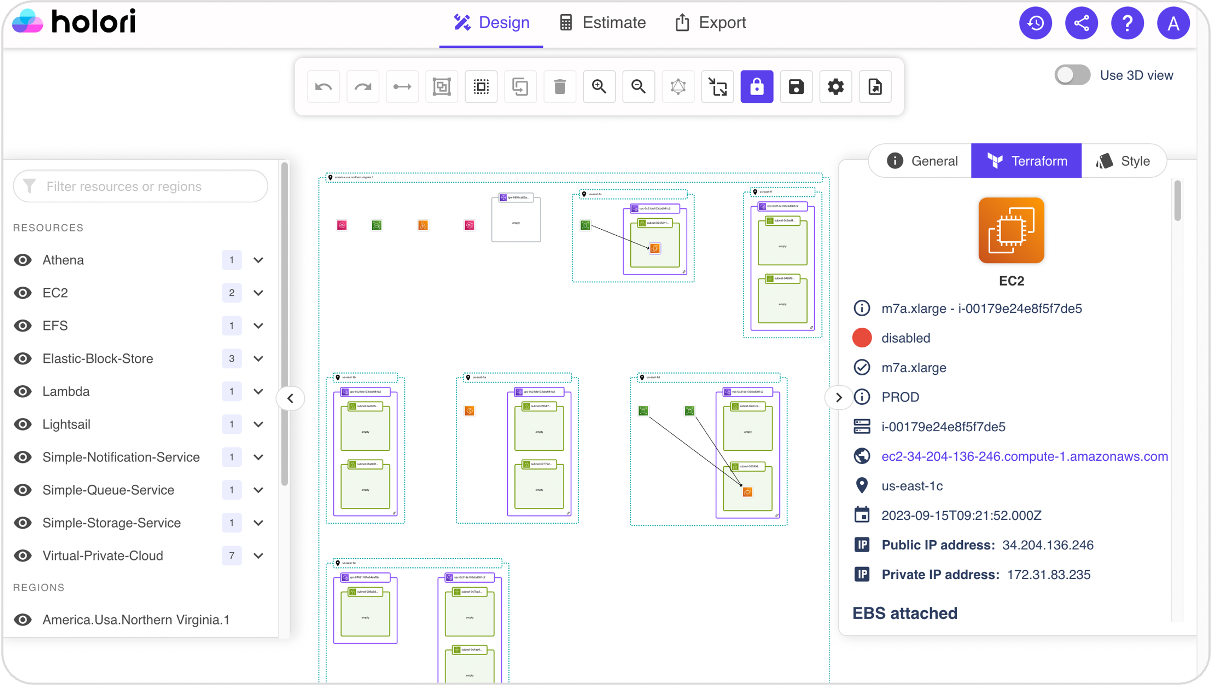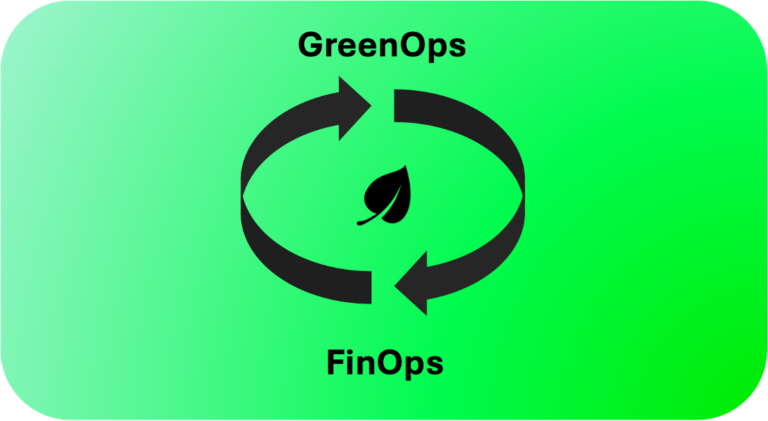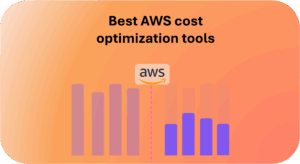If you ask industry leaders which global challenges they would like to tackle regarding the cloud industry, they will most likely say its cost or its environmental impact.
People often believe that optimizing the cost and the environmental impact are two fundamentally different tasks. This is far from being true and we will demonstrate it in this article by explaining how you can leverage on your environmental actions with GreenOps to lower your cloud costs with FinOps.
The rising call for GreenOps
GreenOps focuses on eco-friendly IT practices, specifically within cloud environments. By optimizing resource usage and promoting energy efficiency, GreenOps directly contributes to cost reduction.
In 2024, no one can say that the environmental impact of cloud computing is neglectable. The energy consumption is used to power all servers of course but also to keep the data center cool enough to ensure smooth operations. Cooling down a datacenter requires nearly as much energy as to power them up.
According to the US Office for Energy Efficiency and Renewable Energy, “the electricity consumed in data centers is mainly by the equipment (50%) and air conditioning units (25%–40%) to maintain the room environment”.
Besides air conditioning, most providers also use water cooling, which itself represents enormous quantities of water that are lost every year.
According to NPR.org, “a mid-sized data center in the US consumes around 300,000 gallons (1.14 million liters) of water a day, or about as much as 1,000 U.S. households. Their direct, on-site consumption ranks data centers among the top 10 water users in America’s industrial and commercial sectors.”
Some might argue that the environmental efforts should be carried out by the cloud providers as they are the ones responsible for managing the data centers. This is of course true, however, the actions taken by cloud providers are market driven. The more demand there is, the bigger the datacenters.
This is where cloud users have a role to play and the reason why the concept of GreenOps recently became more important.
GreenOps is an emerging approach focused on integrating environmental considerations into IT operations. It takes into consideration a range of practices aimed at reducing carbon footprints, enhancing energy efficiency, and promoting the use of sustainable technologies.
The key goals of GreenOps include:
- Energy Efficiency: Implementing measures to reduce energy consumption in data centers, such as using more efficient hardware, optimizing cooling systems, and employing virtualization techniques.
- Sustainable Resource Management: Utilizing renewable energy sources, minimizing electronic waste through recycling, and opting for eco-friendly materials in hardware manufacturing.
- Carbon Reduction: Tracking and reducing carbon emissions associated with IT infrastructure and operations.
- Optimizing Resources Usage: Ensuring that the resources used are not exceeding the real needs. Pushing for a dynamic infrastructure management approach where the demand drives the infra size and configuration to ensure that no resource is wasted.
But wait, isn’t optimizing resources usage FinOps? Absolutely! And that’s why synergies between GreenOps and Finops are obvious!
FinOps, a must have in today’s cloud context
Public cloud spending skyrocketed in recent years, driven by the increasing adoption of cloud-native infrastructure services. In a report, Gartner forecasted that the worldwide end-user spending on public cloud services would expand by more than 20% in 2022 to nearly USD 500 billion, reaching nearly USD 600 billion in 2023. This acceleration in cloud migration and investment is followed by concerns about wasteful spending.
FinOps, short for Financial Operations, is a framework designed to manage and optimize the costs associated with cloud computing. It emphasizes a collaborative approach to financial management, involving cross-functional teams to ensure that cloud spending is transparent, efficient, and aligned with business objectives. The main objectives of FinOps are:
- Cost Transparency: Providing clear visibility into cloud expenditures and resource utilization to all stakeholders.
- Cost Optimization: Identifying areas for cost savings through resource allocation, pricing models, and efficient use of cloud services.
- Value Optimization: Ensuring that every dollar spent on cloud services delivers maximum business value and supports strategic goals.
Most companies are aware of the cost challenges. However, not all of them act against it.
FinOps often starts by the awareness about the cloud resources used and challenging their existence and current configuration. Is this resource really needed, is this configuration required or is it an overkill…
The ideal ratio being an infra that works perfectly technically to serve the underlying applications running on it and that doesn’t cost a cent more than it should. Here becomes the tricky topic of identifying first of all for an existing infra all the resources running and assessing their usefulness and ensuring that they are properly configured. Then digging into the costs to identify the main drivers. Cloud costs analysis is far from being simple, it often requires the use of multiple layers of filters or tags to properly allocate an amount of money to the corresponding project, customer, environment or team. Once done it allows clear reporting to each stakeholder of the resources they contribute to consume.
Then can begin the rewarding task of “killing” costs. This can be done by eliminating unused resources then identifying patterns to suggest cost optimization strategies. We recently wrote an article explaining how to implement a successful FinOps strategy.
The goal of this article is not to provide a detailed description of each possible strategy to kill cloud costs but to show how cost saving strategies are fully aligned with environment impact reduction.
The four reasons why GreenOps and Finops are the perfect match:
1. Shared Focus on Resource Optimization:
Both FinOps and GreenOps emphasize efficient cloud resource utilization. FinOps aims to eliminate overprovisioning and underutilized resources, both of which waste money. GreenOps takes this a step further by minimizing wasted compute power and storage, directly reducing energy consumption. This overlap creates a synergy where optimizing resources benefits both your wallet and the environment.
- Rightsizing Resources: A core FinOps principle is rightsizing resources, ensuring you allocate only the necessary compute power, memory, and storage for your workloads. GreenOps aligns perfectly here – rightsizing also reduces energy consumption by eliminating wasted data center resources.
- Autoscaling: Leveraging autoscaling features provided by cloud platforms allows you to dynamically adjust resources based on demand. This eliminates the need for static provisioning, preventing overspending and reducing energy use when workloads are low.
- Eliminating Idle Resources: Identify and shut down idle resources like virtual machines that are not actively being used. This is a key FinOps practice that directly translates to lower energy consumption and cost savings.
2. Cost Savings Through Sustainability:
GreenOps practices like shutting down unused virtual machines and right-sizing workloads lead to lower operational costs. These practices align perfectly with FinOps principles like utilizing pay-as-you-go models and eliminating idle resources. By adopting a GreenOps approach, you can amplify the cost savings achieved through FinOps.
- Reduced Energy Consumption: By optimizing resource usage, GreenOps directly reduces the amount of energy required to power cloud infrastructure. This translates to significant cost savings on your cloud bills, especially for compute-intensive workloads.
- Improved Infrastructure Efficiency: GreenOps encourages a culture of efficiency within IT teams. This focus on optimizing resource allocation not only saves money but also reduces the overall environmental impact of your cloud footprint.
- Sustainable Cloud Choices: Certain cloud providers offer more sustainable infrastructure options, utilizing renewable energy sources or implementing energy-saving cooling technologies. A GreenOps approach can help you identify and leverage these options for an even greater environmental and financial benefit.
3. One team to tackle two challenges as one
Traditionally, FinOps and GreenOps might be managed by separate teams. However, combining them into a single framework eliminates this redundancy. This not only streamlines operations but also reduces overhead costs. Additionally, a unified approach creates better collaboration and communication between teams with shared goals.
- Unified Cloud Management: By merging FinOps and GreenOps practices, you can create a unified cloud management strategy. This eliminates silos and ensures both cost optimization and environmental sustainability are considered throughout the cloud lifecycle.
- Cross-functional Collaboration: Encouraging collaboration between FinOps and GreenOps teams encourages knowledge sharing and the development of horizontal cloud management practices. This integrated approach leads to better decision-making and improved resource utilization.
- Reduced Administrative Burden: A unified FinOps and GreenOps framework streamlines processes and reduces administrative overhead. Teams can leverage common tools and reporting mechanisms, eliminating duplication of effort.
4. Enhanced Transparency:
Today’s Environmental, Social, and Governance (ESG) factors are increasingly important to stakeholders. By consolidating FinOps and GreenOps, you gain greater transparency into both your cloud finances and environmental impact. This allows stakeholders to make informed decisions and hold the organization accountable for its sustainable practices, creating additional value.
- Improved Sustainability Reporting: A combined FinOps and GreenOps approach allows you to develop comprehensive sustainability reports. These reports can track metrics like energy consumption, carbon footprint, and resource efficiency, demonstrating your commitment to environmental responsibility.
- Investor Confidence and Brand Reputation: Stakeholders are increasingly looking to invest in companies with strong ESG practices. By implementing GreenOps alongside FinOps, you can showcase your commitment to sustainability, boosting investor confidence and brand reputation.
- Regulatory Compliance: Certain regulations mandate reporting on energy consumption and carbon footprint. A GreenOps approach can help ensure compliance with these regulations while also driving sustainable practices within your organization.
How can Holori help you implement the perfect Finops and GreenOps strategies?
It’s now clear that gaining insights into your cloud environment, from an infrastructure or cost level is the key to optimizing it. Doing it manually is time consuming and prone to errors. It’s best to rely on dedicated software to help you achieve best in class infra optimization.
At Holori we are building the software enabling full visibility across your infra and its cost.

No blind spot with global infra visibility:
With detailed diagrams to map your cloud infrastructure you gain valuable insights on your cloud assets, their localisation and configuration.
It is a common problem to forget that some resources exist and they keep idling somewhere in your infra, costing you money and wasting resources. At idle state it is estimated that a server still uses approximately 30% of its maximum energy consumption, which is purely wasted money, energy and cooling.
You can easily gain visibility over all your resources and check how they are configured and connected to each other.
Full cost visibility across providers and accounts:
Holori consolidates all your cloud expenses from multiple providers into a single, interactive cost dashboard. This allows you to navigate through the dashboard to gain insights into your cloud spending. You can create virtual tags to gain precise insights across multiple providers. With intelligent filters, you can dive into your cloud costs by department, project, specific resources, or provider tags. This granular level of detail empowers you to understand exactly where your cloud budget is being allocated and identify potential cost inefficiencies.
The key is always to anticipate by defining budget not to exceed and track the evolution of your projects’ costs over time to avoid bad surprises.
Give it a try, you can try for free here: https://app.holori.com
Final words
There is always room for improvement, especially when it comes to GreenOps and Finops.
This is however, a daily battle, don’t expect to have the world’s most optimized infra in terms of cost and environmental impact with a one shot miracle. Implementing the perfect solution is a continuous task. Thankfully thanks to software solutions such as Holori, you can keep track of your cloud infra, its costs and their evolution day after day. The more optimized your infra is the better its environmental impact will be.
Spare the planet… and your wallet!





